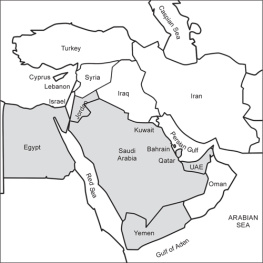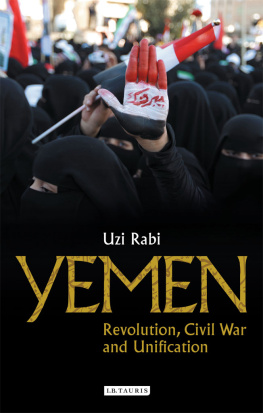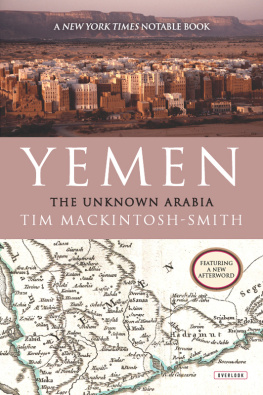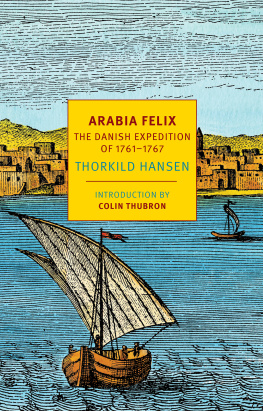IN THE HIGH YEMEN
Scott gives a fascinating account of an expedition that took place in 1937 to the Yemen when the country was closed to Europeans by order of the Imam. Ostensibly a scientific expedition, it possesses great political, cultural, and anthropological interest. The tense negotiations which preceded the expedition and the ultimate success assured that this work remains perhaps the most important account ever written of that forbidding land that occupies the southern half of the Arabian shore.
FRONTISPIECE.
North-east from the summit of Jebel Jihaf towards the mountains of the Yemen: terraced fields of tall green dhurra.
IN THE HIGH YEMEN
Hugh Scott
First published in 2002 by
Kegan Paul International
This edition first published in 2011 by
Routledge
2 Park Square, Milton Park, Abingdon, Oxon, OX14 4RN
Simultaneously published in the USA and Canada
by Routledge
711 Third Avenue, New York, NY 10017
Routledge is an imprint of the Taylor & Francis Group, an informa business
Kegan Paul, 2002
All rights reserved. No part of this book may be reprinted or reproduced or utilised in any form or by any electronic, mechanical, or other means, now known or hereafter invented, including photocopying and recording, or in any information storage or retrieval system, without permission in writing from the publishers.
British Library Cataloguing in Publication Data
A catalogue record for this book is available from the British Library
ISBN 10: 0-7103-0786-1 (hbk)
ISBN 13: 978-0-7103-0786-6 (hbk)
Publishers Note
The publisher has gone to great lengths to ensure the quality of this reprint but points out that some imperfections in the original copies may be apparent. The publisher has made every effort to contact original copyright holders and would welcome correspondence from those they have been unable to trace.
PREFACE
P ROVISION has been made for the appearance of the technical reports of the British Museum (Natural History) Expedition to South-West Arabia, 19378, in a special publication to be issued in parts by the Museum. Despite the war it has been possible to produce a first part of this publication early in 1941.
Outside the purely technical results of the Expedition there remained much that is worthy of publication, both of general natural history and relating to the country itself and its people, based on our memories and impressions and on very full notes written on the spot, as well as hundreds of photographs. This led me and my fellow-traveller, Everard B. Britton, M.Sc. (a colleague with me on the Museum staff), to contemplate writing jointly an account more general and popular than could be included in the official publication. But the months immediately following our return to England were occupied with the preliminary task of preparing and sorting the thousands of specimens and hundreds of photographs brought back. By the time a joint scheme for a book had been drafted and work started thereon, the war had broken out and, shortly after, my collaborator was called away. I can only thank him cordially for his ardour, helpfulness and hard work during the Expedition, and for the later work which greatly assisted me in planning this book.
As it now appears, with the framework reshaped, the book is in three parts. In the first I have tried to explain simply the scientific questions which prompted us to undertake the journey, and the methods used in carrying out our work. Though new to travel in South-West Arabia, I was not entirely a stranger (either in personal experience or reading) to countries abutting on the southern end of the great Red Sea rift, and my interest in the problems which they suggest was not new. Readers must not, however, expect a complete answer to the scientific riddles here. Even in normal times some years of labour are needed to work out in detail the results of such an expedition. Under present conditions, with colleagues, collections and libraries scattered and intercourse with scientists in many countries cut off, the task promises to be even longer.
The second part, the bulk of the book, is a personal narrative of our journey in two Arabian countries. The Western Division of the Aden Protectorate (as opposed to the Hadhramaut in the Eastern Division) is still far from familiar to the general reader. The Kingdom and Imamate of the Yemen is a closed mysterious country, its ruler is a sacred personage, holder of a centuries-old office, combining in himself spiritual and temporal sovereignty. The routes we traversed are known to very few living Europeans (or Americans) and to only a handful of British. There is no up-to-date book by any English writer on these countries, the former an important part of a very large British Protectorate, the latter an independent realm of much consequence politically and otherwise owing to its common frontier with British territory. Indeed these lands ought to be better known to readers at home. Thus it seemed worth while to record the observations of two travellers primarily naturalists, but also intensely interested in many other aspects of the country, its peoples, customs and architecture, and its several ancient civilisations. Much relating to these matters is woven into the narrative. Personal experiences, small or trivial in themselves, and intercourse with individuals, will also often shed light on a strange and little-known land.
In the third have tried to summarise briefly the present state of knowledge of the tribes inhabiting this part of Arabia, of the dawn of human history there and the subsequent history before and since the coming of Islam. This portion is a compilation of facts and opinions to which I do not claim to have added anything original. But no book, least of all in English, exists in which even an outline of these subjects is brought together under one cover. Many aspects of the narrative will be better understood if the historical sections are read. Finally a very short chapter is added on some of the products and possibilities of development of this corner of the vast Arabian peninsula.
HUGH SCOTT.
HENLEY-ON-THAMES,
1942.
CONTENTS
Note of Acknowledgment
A CKNOWLEDGMENTS of the generous support and help which I received both in England and Arabia in carrying out the Expedition have been expressed elsewhere. It is now a pleasure to thank the institutions and persons who have assisted me during the writing of this volume. Sincere thanks are tendered to Sir Bernard Reilly, K.C.M.G. (Governor of Aden at the time of the Expedition), for kind help and advice regarding many matters; to the Trustees of the British Museum for sanctioning publication of the Map of Sana District; to the Royal Geographical Society for kindly allowing inclusion of the route-map and the plan of Sana, and certain other illustrations which appeared in the Geographical Journal for February, 1939; to the Royal Central Asian Society for permitting inclusion of four text-figures and other illustrations published in their Journal











